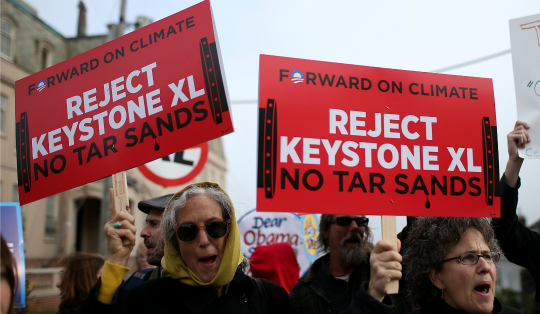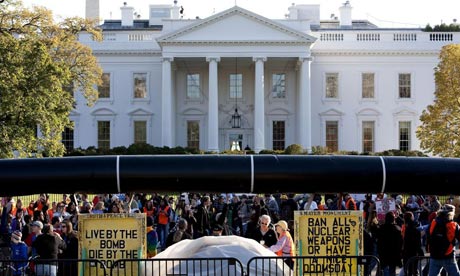Published on Friday, January 31, 2014 by Common Dreams
McKibben: “The State Department has given Obama all the room he needs to do what he promised in both campaigns: to take serious steps against global warming.”
– Jacob Chamberlain, staff writer

Protestors demonstrated against the Keystone XL pipeline in San Francisco last year. (Photo: Getty Images)The State Department released its Final Environmental Impact Statement (FEIS) of the Keystone XL pipeline on Friday. Environmental groups and climate activists are saying that given Obama’s promise to judge the project on its climate impacts there is no way—given the review’s contents—he can possibly approve it now.
In a press call following the release of the review, 350.org co-founder Bill McKibben said that a close reading of the report shows that the climate impacts it recognizes are undeniable.
“The report concluded that in a scenario where we take climate change seriously and regulate climate pollution, this pipeline will indeed have a ‘significant impact’ on climate change,” said McKibben. “So now we’ll find out if that’s the world Barack Obama and John Kerry want. This report gives President Obama everything he needs in order to block this project. This is the first environmental issue in years to bring Americans into the streets in big numbers, and now they’ll be there in ever greater numbers to make sure the President makes the right call.”
“President Obama now has all the information he needs to reject the pipeline. Piping the dirtiest oil on the planet through the heart of America would endanger our farms, our communities, our fresh water and our climate. That is absolutely not in our national interest. Keystone XL should be rejected.” —Susan Casey-Lefkowitz, NRDC
Following reports in the corporate media indicating that the final environmental review gives the go-ahead for the Obama administration to approve the controversial pipeline, environmental groups are calling this wishful thinking that accepts the spin of the fossil fuel industry. According to climate experts, the report actually corresponds to what the scientific evidence has shown all along—that the Keystone XL pipeline is dangerous, carbon intensive, hard to clean up, and the dirtiest fuel on the planet.
“The new review represents an important shift from prior analyses because it no longer tries to claim that Keystone’s impacts will be negligible,” said Bill Snape, senior counsel with the Center for Biological Diversity. “But even so, the environmental consequences are clear as day: oil spills, polluted rivers, and wildlife directly in harm’s way.”
According to the Sierra Club:
“Even though the State Department continues to downplay clear evidence that the Keystone XL pipeline would lead to tar sands expansion and significantly worsen carbon pollution, it has, for the first time, acknowledged that the proposed project could accelerate climate change,” said Susan Casey-Lefkowitz of the Natural Resources Defense Council. “President Obama now has all the information he needs to reject the pipeline. Piping the dirtiest oil on the planet through the heart of America would endanger our farms, our communities, our fresh water and our climate. That is absolutely not in our national interest. Keystone XL should be rejected.”
“Keystone XL will transport nearly a million barrels of highly toxic tar sands oil through America’s heartland each and every day for 50 years or more — only to have much of it refined and exported,” said Snape. “Along the way it will crush some of the last habitat for endangered species like the swift fox and whooping crane. It’ll pollute water used by millions of people and emit as many greenhouse gases as 51 coal-fired power plants.”
“The State Department acknowledges there is risk to our water and Keystone XL will increase tarsands production,” said Jane Kleeb, Bold Nebraska executive director. “TransCanada is fighting for their bottom line, while farmers and ranchers are fighting for their livelihoods and the Ogallala Aquifer which at one point our Governor stood with us to protect. We are in this fight to win and are confident Pres. Obama will make the right decision and deny the permit.”
“The State Department has given Obama all the room he needs to do what he promised in both campaigns: to take serious steps against global warming,” said McKibben earlier on Friday. “He’s about the only person who hasn’t weighed in on Keystone XL; now we’ll see if he’s good for his word.”
As 350.org said in a press statement: “Don’t let the convoluted process fool you. This is President Obama’s decision and his alone–and he has all the information he needs to reject the Keystone XL pipeline. The President has already laid out a climate test for Keystone XL, that it can’t significantly increase greenhouse gas emissions. It’s clear that Keystone XL fails that test.”
No final decision from the Obama administration has yet been made. The process now opens up to a 30-day public comment period.
And as the Associated Press reports: “The Environmental Protection Agency and other departments will have 90 days to comment before State makes a recommendation to Obama on whether the project is in the national interest. A final decision by the government is not expected before summer.”
On Twitter, key members of the climate movement were pointing out the fallacies and corporate spin they saw in early reporting on the FEIS by some:
Michael Brune @bruneski
Follow
Don’t believe the oil industry’s hype. State Dpt analysis shows tar sands oil is more toxic, more corrosive, & more carbon-intensive. #nokxl
3:22 PM – 31 Jan 2014


